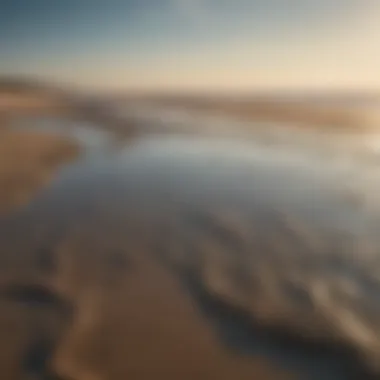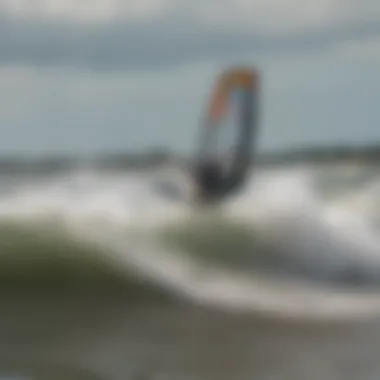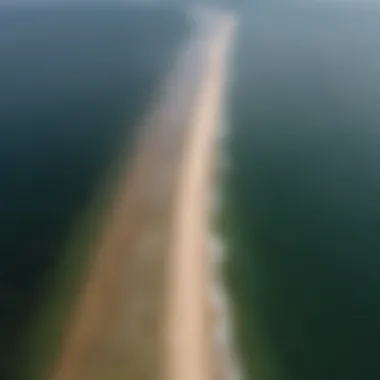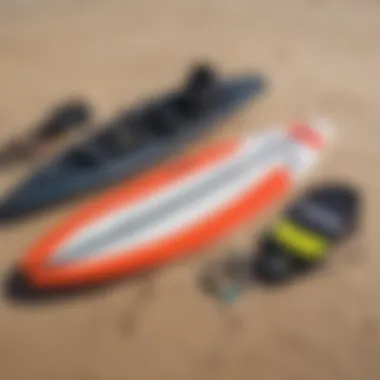Understanding Barnstable Tides for Kitesurfing & Kiteboarding


Intro
When it comes to kitesurfing and kiteboarding in Barnstable, understanding the tides is like hitting the jackpot. Tides play a crucial role in shaping the water conditions, affecting everything from wave height to wind patterns. For a keen enthusiast, grasping the rhythm of the sea can either make or break a session on the water.
This guide dives deep into the intricacies of Barnstable’s tides, presenting an engaging narrative that not only informs but empowers riders of all skill levels.
In this exploration, we'll touch base on various aspects like safety measures, equipment reviews, and methods that can enhance your riding experience. Knowing the lay of the land—or in this case, the tide—can make all the difference. So, strap in as we break it down into digestible bits!
Preamble to Barnstable Tides
When kitesurfing and kiteboarding, understanding the tides in Barnstable is not just beneficial; it's crucial. Tides influence water conditions, currents, and overall safety. For a kitesurfer, knowing how these factors intermingle can enhance the riding experience. This section lays the groundwork for comprehending Barnstable's tidal patterns and their implications for water sports.
Geographical Overview
Barnstable is situated on Cape Cod, Massachusetts, where the ocean unravels its playful tides. The coastline here is dotted with beaches and inlets, which means that tide dynamics can vary dramatically depending on location. This variety offers different conditions: some spots are ideal for beginners, while others challenge even seasoned riders. The shallow waters near some beaches might mean that kitesurfing is more navigable during high tide, while low tide can reveal sandbars and rocks, creating obstacles that will test one's skills and awareness.
However, it’s not just about the immediate beach. The surrounding geography, including marshes and rivers, also impacts tidal flow. For instance, the confluence of fresh and salt waters can lead to unique conditions whenever tides change. So, understanding the locality can give enthusiasts a leg up in planning their sessions appropriately.
Historical Context of Tides
Tides in Barnstable are not just a daily rhythm; they have roots in the history and economy of the area. Historically, local fishermen and mariners depended on precise knowledge of the tides, shaping their practices and livelihoods around these natural movements. As time goes on, the nuances of tides continue to be significant for present-day water-sport enthusiasts.
In times gone by, communities focused on fishing took note of tidal cycles, which dictated when certain fish species would be plentiful. That same historical wisdom can be translated into the kitesurfing culture of today.
Moreover, interestingly enough, Barnstable's tidal fluctuations have been studied and recorded for decades, allowing modern riders to refer to a wealth of data. Understanding how these patterns have shifted or remained consistent over time can provide valuable insights into present conditions.
"Patterns of the past can guide the choices of the present and future."
As kitesurfers or kiteboarders immerse themselves in the waters of Barnstable, they engage not only with the tides but also with the rich history of this unique region.
The Science Behind Tides
Understanding the science behind tides is not just an academic exercise; it's the foundation of successful kitesurfing and kiteboarding in Barnstable. Tides dictate water conditions, influencing how and when enthusiasts hit the water. For anyone planning to ride the waves, grasping these concepts can mean the difference between a thrilling experience and a challenging, potentially risky one. Each tide brings with it unique characteristics that can enhance or diminish the quality of the kitesurfing experience.
Gravitational Forces
At the core of tidal movements lie gravitational forces. The moon and, to a lesser extent, the sun exert their gravitational pull on the Earth's waters. As the moon orbits, it pulls water toward it, creating a bulge. This bulge is what we recognize as high tide. Conversely, as the Earth rotates away from that bulge, low tide occurs.
In Barnstable, the effect of these gravitational forces can be quite nuanced. The positioning of the moon will not only cause regular high and low tides, but it also affects how strong those tides are.
"Tides are like the breathing of our oceans; understanding the rhythm can transform the way you experience the water."
Earth's Rotation and Its Impact
Earth doesn't just sit still; it spins on its axis, and this rotation has a significant effect on tidal patterns. As Earth rotates, the timing of tides shifts, resulting in two high tides and two low tides every day for most coastal areas, including Barnstable. While this regularity might make it seem simple, various local geographical features complicate the idea.
Different coastlines can experience tides at different times due to the shape of the land and the continental shelf. In Barnstable, riders need to be aware that their prime time for kitesurfing might vary by an hour or two depending on the day's specific tidal conditions. Riders should monitor tide schedules to optimize their sessions while keeping a keen eye on the horizon for upcoming tidal changes.
Local Factors Influencing Tides


It's easy to think of tides as a straightforward phenomenon, but local factors play a massive role in their behavior. Barnstable's coastline, including its lagoons, shores, and inlets, creates unique tidal patterns that can surprise the unprepared.
- Geographical Layout: The shape of the coast can either amplify or reduce the effect of tidal ranges. In Barnstable, certain areas can flood quickly while others may remain shallow much longer.
- Weather Conditions: Wind, rain, and atmospheric pressure can all skew expected tide levels. For instance, strong winds from the north can push water into the bays, causing unusually high tides.
- Man-made Structures: Jetties and piers can change flow dynamics, leading to local zones of very high or low tide that can shift unexpectedly.
Kitesurfers should take time to familiarize themselves with Barnstable's local conditions, recognizing how changing specifics can create vastly different riding experiences. Whether it’s grabbing a swell or avoiding strong currents, knowledge of these elements proves invaluable for the savvy kitesurfer.
Tidal Patterns in Barnstable
Understanding tidal patterns in Barnstable is akin to reading the water's pulse. These rhythms are not merely a backdrop but actively shape the conditions for kitesurfing and kiteboarding. Knowing when the tides rise and fall is crucial for riders, as it directly affects everything from water visibility to current strength. A solid grasp of these patterns can enhance one's performance and enjoyment while minimizing the risks associated with unpredictable nature.
Daily Tidal Cycles
In Barnstable, daily tidal cycles follow a semi-diurnal pattern, meaning there are typically two high tides and two low tides each lunar day. This regularity can be beneficial for kitesurfers, as it provides predictable windows for riding. For instance, if you know that high tide occurs around 2 PM on a given day, you can plan your session to align with that peak water level, thus taking advantage of smoother conditions for your stunts and maneuvers.
However, it isn’t only about the timing. The water behaves differently depending on whether it's coming in or going out. During high tide, the water can feel like a blessing, giving riders a chance to glide with less obstruction. As it recedes, currents can increase speed and create choppy surfaces, requiring more technical skill to navigate. Recognizing these daily shifts allows kitesurfers to work smarter, not harder.
Seasonal Variations
As seasons change, so do tidal patterns in Barnstable. Summer months bring increased tidal ranges and a more dynamic flow, often influenced by weather systems. Conversely, during the winter, tides may exhibit less variation due to cooling weather patterns that stabilize currents.
- Summer riding: With longer days and fluctuating tides, summer offers a playground for kitesurfers eager to try out new moves. Riders may find more optimal conditions during this time.
- Winter challenges: Cold weather can reduce session frequency, but those brave enough to venture out may find unique opportunities in calmer waters.
Being aware of these seasonal changes can assist riders in planning ahead, as conditions can fluctuate dramatically from month to month. Knowing what to expect at different times of the year can make the experience both safer and more enjoyable.
Spring vs. Neap Tides
There’s a fascinating dance between spring and neap tides that every kitesurfer should recognize. Spring tides, occurring during the full moon and new moon phases, exhibit the largest differences between high and low tides. This creates more opportunities for kitesurfers who thrive on the excitement of powerful, luscious tides. Rides can be exhilarating, but they also come with the potential for stronger currents.
On the other hand, neap tides, which take place during the first and third quarters of the moon, feature minimal tidal shifts. For many kitesurfers, neap tides can be considered a safer option, especially for those who are still securing their skills on the water.
The tide's behavior can change how and where you ride. Sometimes spring tides give you the boost you need to explore different spots, while neap tides can serve up a smoother, steadier experience on familiar waters. Both have their place in the kitesurfer's calendar, and savvy riders will keep both in mind to maximize their time riding.
"Mastering the tides is like learning the art of dance — timing and rhythm are everything."
Understanding these elements of tidal patterns can empower riders to make informed decisions, enhancing their kitesurfing and kiteboarding experiences all year round.
Tides and Kitesurfing Dynamics
Understanding the interplay between tides and kitesurfing dynamics is vital for anyone looking to make the most of their time on the water. Here, we dive into how tidal movements affect everything from wave patterns to rider safety, guiding both novice and seasoned kitesurfers through the often murky waters of tide-related challenges and advantages.
Impact on Water Conditions
Tides profoundly influence water conditions, which in turn can dictate kitesurfing experiences. As the ocean rises and falls with the tidal cycles, factors such as wind direction, speed, and even the presence of obstacles like sandbars come into play. During high tide, for instance, you may find smoother, deeper waters, which are perfect for speed and skill maneuvers. Conversely, low tides expose more land, creating shallow areas that can present both advantages and difficulties. This might mean more challenges with the board getting stuck in the shallows or the necessity to navigate around sandbanks.
Moreover, the changing tides affect the flow of currents. High tide typically results in slower currents near the shore, offering a more forgiving environment for kitesurfers, especially during learning stages. At the same time, lower tides can lead to stronger, more turbulent water flows, demanding higher skill levels. . This creates a constant dance where riders must adapt to the ever-shifting conditions dictated by the tides.
"It's like trying to ride a wave and a rollercoaster at the same time. You gotta know when to hold on and when to let go."
Ultimately, recognizing how these water conditions shift is critical. Noting local tidal charts and understanding their connection with wind patterns can be a game-changer for kitesurfers looking to catch the best conditions.
Choosing Optimal Riding Times


Timing is everything in kitesurfing, and knowing when to hit the water can significantly enhance your session. Timing your kitesurfing activities with the tides allows riders to utilize the most suitable conditions for their skill levels and desired experiences.
Based on tidal patterns, there are generally two key riding windows to consider: right before high tide and just before low tide. Riding before high tide generally grants a broader area of deeper water, making it easier to perform tricks without the fear of running aground. On the flip side, the low tide often results in exhilarating wave conditions that can be perfect for those who like to challenge themselves.
Here are some tips for selecting the best times to ride:
- Consult Tidal Charts Regularly: Familiarize yourself with local tide schedules and adjust your riding times accordingly.
- Assess Wind Conditions: Always consider wind direction and speed; it can greatly affect the experience, especially during different tides.
- Connect with Local Riders: Engaging with experienced locals can offer valuable insights into the best times to ride, often based on anecdotal experiences.
- Be Cautious of Quick Tidal Changes: Sometimes, tides can shift much quicker than anticipated. Stay aware of timing to avoid getting caught in challenging situations.
In the world of kitesurfing, knowing these tidal nuances can mean the difference between a day of exhilarating rides and an experience fraught with unnecessary hurdles. You can't control the tides, but you can sure learn how to dance with them.
Safety Considerations
Kitesurfing is not just a thrilling sport; it's one that comes with its own set of risks, especially in tidal areas like Barnstable. Understanding safety considerations comprehensively is paramount for any kitesurfer or kiteboarder aiming to navigate these waters skillfully. It's essential to be aware of the changing environments posed by tides to ensure a safe and enjoyable experience on the water.
Risks Associated with Tidal Changes
Tides are as unpredictable as they are compelling. The danger lies in their capacity to alter water levels rapidly, which can create unforeseen hazards for riders. For instance, a high tide can create stronger currents, while a low tide can expose underwater obstacles that are normally submerged. This shifting landscape can turn an idyllic session into a perilous situation.
Moreover, local conditions often exacerbate the risks. The interplay between wind direction and tidal patterns can ramp up wave heights and increase the difficulty of landing jumps. Knowing when these changes occur is critical.
Regularly checking tide charts and local weather reports can help mitigate these risks. By investing a bit of time into research before heading out, enthusiasts can avoid unpleasant surprises.
"Knowledge is not a substitute for experience, but it lays a solid groundwork for safe practices."
Navigating Strong Currents
Strong currents can be found in Barnstable, and they can be tricky to manage. Navigating these waters requires both skill and awareness. When the tide is coming in or out, it can generate currents that increase in speed, making it vital for riders to maintain control over their kite and board.
A few tips to tackle strong currents include:
- Positioning: Start from a point where you can keep an eye on the current. Always opt for shallow water to avoid being swept away.
- Kite Control: Keep your kite low if you're approaching a powerful current. This will help provide better control and maintain stability.
- Buddy System: Riding with a partner can be beneficial, as you can look out for each other in case of sudden changes.
Adaptability is key. The ability to adjust your riding style based on the current conditions can mean the difference between a fun ride and a dangerous situation.
Best Practices for Safety
To make the most out of kitesurfing in Barnstable, safety practices must be second nature. Here are some recommended best practices:
- Pre-ride Checks: Inspect your equipment thoroughly. Make sure your lines, kite, and board are all in prime condition.
- Know the Area: Become familiar with local landmarks and known hazards. Understanding the locale helps in recognizing safe zones.
- Stay Educated: Join local forums like Reddit or communities on Facebook. Engaging with fellow enthusiasts can provide insights into recent tidal patterns and safety tips.
- Emergency Protocols: Have a plan in place for emergencies. Know how to signal for help and where to find assistance should you need it.
- Limit Riding Time: Avoid riding during extreme tidal shifts. Timing your sessions can ensure that you are not caught off guard.
By weaving together these practices, kitesurfers can greatly reduce their chances of an accident, allowing them to enjoy the thrill the sport has to offer while keeping safety at the forefront.
Equipment Considerations for Tides
When it comes to kitesurfing in Barnstable, understanding the implications of tides on your equipment can't be overstated. The tides directly influence water conditions, which in turn affect the performance of your kite and board. Choosing the right gear isn't just a matter of personal preference; it's a critical aspect that can lead to a better experience on the water as well as safety.
Kite Selection Based on Conditions
Selecting a kite that suits the tidal conditions is akin to picking the right tool for the job. With tidal fluctuations, wind behavior can vary dramatically. In high tide, the water can get quite choppy, while low tide might leave exposed sandbars and shallower areas. Here are some point to ponder:


- Kite Size: For example, a larger kite is typically more favorable in lighter winds, while a smaller kite can handle stronger gusts. During neap tides, when the water level doesn’t change significantly, you might want a medium-sized kite for versatile performance.
- Kite Style: Also consider the design. Freeride kites offer stability on the water and are acceptable in a variety of conditions. However, if you’re looking to push limits during spring tides—where water moves swiftly—a more aggressive bow kite might be the choice.
- Wind Direction: Look at how the wind interacts with the tide. If the wind is coming from a direction opposite to the tide, that can create rough patches. Picking a kite that can handle this sort of behavior will keep you afloat, quite literally.
As expert kitesurfers will tell you, adapting your gear to reflect these considerations can make all the difference in how well you master the waves.
Board Design for Tidal Areas
The type of board you’re riding is also significant when it comes to kitesurfing in tidal waters. Barnstable’s unique conditions create a need for thoughtful board selection.
- Size and Shape: Longer boards generally provide better stability in rough waters but can be harder to maneuver. In contrast, a shorter board might be easier to handle during quick turns, particularly in shallow waters. Balancing size with control is key.
- Fin Configuration: Fin size and configuration can profoundly influence how your board tracks through changing tidal currents. Smaller fins might allow for easier maneuvering but could slip out in faster-moving water—think about it like driving a small car versus a big truck on a winding road.
- Materials: Lightweight materials are advantageous in tidal areas because they keep the board buoyant, especially vital during low tide when you may find yourself gliding over the shallows. A composite board often strikes a balance between durability and performance on the various surfaces you may encounter.
Choosing the right kite and board isn't just about what looks good or feels good; it’s about responding to the environment effectively. A well-considered selection of equipment can significantly enhance your kitesurfing experience, especially when navigating the whims of Barnstable's tides. Remember:
"A good kitesurfer adapts to the tide; a great one knows their equipment inside and out."
Ultimately, investing the time to understand these elements of equipment can save you from unnecessary challenges and help you ride the tides to your advantage.
Local Guidelines and Resources
When engaging in kitesurfing and kiteboarding, understanding local guidelines and resources is pivotal. These guidelines not only ensure safety but also promote a sustainable environment for everyone involved. As the tides ebb and flow, so too do the rules and insights provided by local authorities and communities. Keeping abreast of these details can significantly enhance one's experience on the water.
Regulatory Bodies and Their Role
Local regulatory bodies play a crucial role in managing kitesurfing and kiteboarding activities. In Barnstable, agencies like the Barnstable Harbormaster's Office enforce regulations that help maintain safety on the water. These regulations can include:
- Designated Kitesurfing Zones: Certain areas are marked specifically for kitesurfing to keep riders safe and minimize conflicts with other water users.
- Tide Schedules: Information on the timing of high and low tides can help kitesurfers plan their outings in a timely manner, making the most of the surf conditions.
- Environmental Regulations: Some regions have restrictions to protect sensitive habitats and wildlife, especially during nesting seasons.
Following these guidelines is not just a matter of compliance; it can often mean the difference between a thrilling day on the water and an unfortunate mishap. Keeping the line of sight to these regulatory bodies can help you stay updated.
Community Forums and Support
In addition to regulatory bodies, community forums and support networks play an essential part in the kitesurfing landscape. Platforms such as Reddit and Facebook groups dedicated to kitesurfing in Barnstable allow enthusiasts to share experiences, tips, and local knowledge. This informal network can provide vital insights into:
- Weather Conditions: Riders often share real-time updates about wind and tide conditions, which can be particularly useful for planning last-minute sessions.
- Local Events: Community gatherings or competitions are often highlighted in these forums, allowing both recreation and camaraderie.
- Gear Recommendations: Knowledge on what equipment fares best in specific tidal conditions is invaluable and can often be found through discussions in these groups.
Engaging with community forums is a great way to not only expand your own knowledge but also build a network of fellow kitesurfers who can enrich your experiences on the water.
As the tide changes, so do the conversations around kitesurfing. Participating in these communities will not only help in understanding local conditions but will also foster a sense of belonging amongst enthusiasts.
The synthesis of regulatory input and community support is crucial for every kitesurfer. By leveraging both, you can significantly elevate your kitesurfing experience while ensuring safety and sustainability in Barnstable's dynamic waters.
Epilogue
The exploration of Barnstable's tides is essential for anyone keen on kitesurfing and kiteboarding in this dynamic region. Understanding these tidal influences, rather than merely glossing over them, equips enthusiasts with the necessary knowledge to navigate the waters safely and effectively.
Summary of Tidal Influences
The tides in Barnstable play a pivotal role in shaping the conditions for kitesurfing. Here are some key points regarding their influence:
- Tidal Height: The varying heights of tides significantly change the water's surface and, by extension, the riding experience. High tides often provide more water and reduce obstacles like sandbars, while low tides may expose them, creating challenges for riders.
- Current Strength: The speed of currents changes with tidal flow. Strong currents during tide changes can pose risks. Kitesurfers must gauge these currents to prevent accidents and enjoy their ride.
- Wind Conditions: Tides can influence wind patterns, affecting the kitesurfing experience. Understanding when winds will be favorable or unfavorable, relative to the tide, can vastly improve the performance on the water.
Overall, knowing the nuances of tidal influences can be the difference between a thrilling ride and a frustrating experience.
Future Considerations for Kitesurfers
As tides continue to change, kitesurfers must also adapt and consider the following:
- Environmental Changes: Climate change could affect tidal patterns over time, leading to alterations in riding conditions. Staying updated on technological advancements and environmental statistics is crucial.
- Adaptive Equipment: As riders face evolving tide conditions, choosing adaptable gear becomes essential. This could include kites with varying sizes/attributes that can handle different tidal scenarios.
- Collaborative Learning: Engaging with local kitesurfing communities, such as forums on reddit.com or platforms like facebook.com, can offer insights into real-time conditions and effective techniques.







